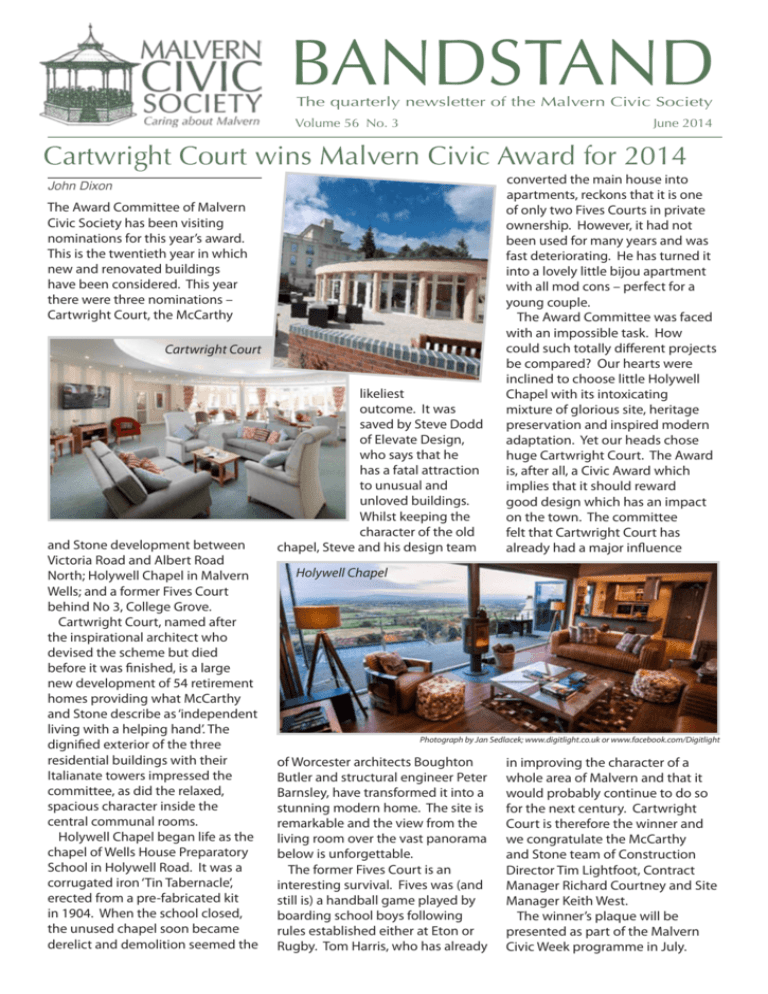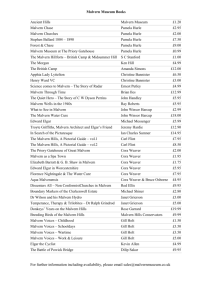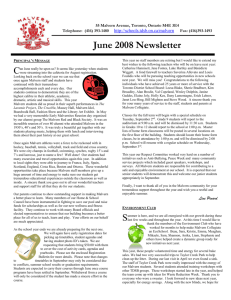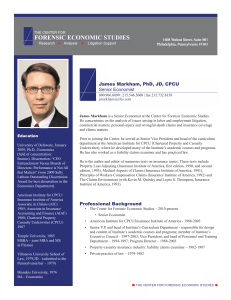bandstand - Malvern Civic Society
advertisement

BANDSTAND The quarterly newsletter of the Malvern Civic Society Volume 56 No. 3 June 2014 Cartwright Court wins Malvern Civic Award for 2014 John Dixon The Award Committee of Malvern Civic Society has been visiting nominations for this year’s award. This is the twentieth year in which new and renovated buildings have been considered. This year there were three nominations – Cartwright Court, the McCarthy Cartwright Court and Stone development between Victoria Road and Albert Road North; Holywell Chapel in Malvern Wells; and a former Fives Court behind No 3, College Grove. Cartwright Court, named after the inspirational architect who devised the scheme but died before it was finished, is a large new development of 54 retirement homes providing what McCarthy and Stone describe as ‘independent living with a helping hand’. The dignified exterior of the three residential buildings with their Italianate towers impressed the committee, as did the relaxed, spacious character inside the central communal rooms. Holywell Chapel began life as the chapel of Wells House Preparatory School in Holywell Road. It was a corrugated iron ‘Tin Tabernacle’, erected from a pre-fabricated kit in 1904. When the school closed, the unused chapel soon became derelict and demolition seemed the likeliest outcome. It was saved by Steve Dodd of Elevate Design, who says that he has a fatal attraction to unusual and unloved buildings. Whilst keeping the character of the old chapel, Steve and his design team converted the main house into apartments, reckons that it is one of only two Fives Courts in private ownership. However, it had not been used for many years and was fast deteriorating. He has turned it into a lovely little bijou apartment with all mod cons – perfect for a young couple. The Award Committee was faced with an impossible task. How could such totally different projects be compared? Our hearts were inclined to choose little Holywell Chapel with its intoxicating mixture of glorious site, heritage preservation and inspired modern adaptation. Yet our heads chose huge Cartwright Court. The Award is, after all, a Civic Award which implies that it should reward good design which has an impact on the town. The committee felt that Cartwright Court has already had a major influence Holywell Chapel Photograph by Jan Sedlacek; www.digitlight.co.uk or www.facebook.com/Digitlight of Worcester architects Boughton Butler and structural engineer Peter Barnsley, have transformed it into a stunning modern home. The site is remarkable and the view from the living room over the vast panorama below is unforgettable. The former Fives Court is an interesting survival. Fives was (and still is) a handball game played by boarding school boys following rules established either at Eton or Rugby. Tom Harris, who has already in improving the character of a whole area of Malvern and that it would probably continue to do so for the next century. Cartwright Court is therefore the winner and we congratulate the McCarthy and Stone team of Construction Director Tim Lightfoot, Contract Manager Richard Courtney and Site Manager Keith West. The winner’s plaque will be presented as part of the Malvern Civic Week programme in July. www.malverncivicsociety.org.uk Malvern Civic Society From the Chairman Clive Hooper It is a busy time for the Society. A host of events are coming up in June in our Civic Week programme. (This year, as we know, there is an Edwardian theme, and some of us are even proposing to dress up in moderately authentic costume for the parade from Church Street to Barnard’s Green: I am sure it will be a sight to behold!) Outings and local visits are well under way, and there is much for us to monitor and pursue with planning issues. Meanwhile, the Friends of Malvern’s Cemeteries and the Friends of Malvern’s Railway groups are actively continuing with their restoration projects, including exciting possibilities for the rebuilding of Great Malvern Station’s clock tower. In the last edition of Bandstand, mention was made of the community’s right to nominate buildings and land as Assets of Community Value (ACVs), and since then – as our press release reported -- submissions have been made both for The Grange and for the old Community Hospital to be listed as ACVs. I have been greatly encouraged by the expressions of support from within the Society and beyond for our action on these two important properties, and particularly The Grange. The Grange is actually owned by Malvern Hills District Council and, as it happens, has now just been offered for sale. We are, therefore, discussing with the Council the possibility of a Community Asset Transfer (CAT). If we do manage to secure The Grange for the community, there will be much work to be done in establishing which community groups might wish to use the premises, in drawing up a business and fund-raising plan, and then in setting up an appropriate body to administer the building and its use. Anyone in the Society, therefore, who has had previous experience in putting together such plans and bidding for grants, and who would be willing to join us, would be greatly welcomed in this important work. Please let me know if you think you may be able to help. This brings me to thoughts about the Executive Committee membership and the AGM in November. We should greatly welcome more help from members in all our many different activities. So, if you feel able to give some of your time, do speak to me or any member of the Executive Committee. Notes from the Membership Secretary We welcome the following new members: Robin Brighton Paul Eyton-Jones David Lawrence Iain McKay Diana and Roger Morgan Sue Orgill Sally Pointer Ralph and Penny Ward Email addresses - We are grateful to the many members who have provided an email address for routine correspondence, circulars etc. If you do have email and have not yet notified the Society of your address please consider doing so. Also please inform us of any changes to contact details; address, phone number, email addresses etc. Details can be passed to me or to any member of the Committee. Philip Robinson membership@malverncivicsociety.org.uk 01684 893490 THE BOARDING SCHOOLS OF MALVERN In this issue________________ May Place, Southlea, Lawnside, Scarborough House…Society Civic Society Award 1 member Iain MacLeod is working on a university dissertation From the Chairman 2 Confusion in local planning 3 Civic Week 2014 4 Edwardian Malvern 4 An Edwardian house 5 about the boarding schools which flourished in Malvern in the late nineteenth and early twentieth centuries. He is looking into the sort of children who went to these schools, the people who owned them and taught in them and the sort of education they offered, to girls as well as to boys. The archivist at Malvern St James is already giving invaluable support, but if any members of the Society know of documents which might help with this research – school magazines News from Malvern cemetery 6 Great Malvern Priory’s bells 7 or prospectuses, for example – Iain would be delighted to hear from Malvern’s Railway Group 7 them on 01684 575317 or iainmacleod173@btinternet.com. Forthcoming events 8 2 BANDSTAND June 2014 Confusion in local planning Bob Tilley Bob Tilley at Hayslan Fields With permission of Worcester News Recent local newspaper reports about the proposed development at Hayslan Fields must leave Malvern residents very confused. The local planning authority, Malvern Hills District Council, has designated the area as an Urban Green Space in the current Local Plan, and in the emerging South Worcester Development Plan (SWDP). The land is owned by Malvern St James School which wishes to sell it and use part of the funds for a bursary scheme to support local children, but generations of Malvern residents have used the 15.5 acre open space for leisure and recreational purposes. Now a development company, Barwood, has come forward with a plan for 150 houses and Bob Tilley, Chairman of the Civic Society Planning SubCommittee, is adamant that the development should be opposed by MHDC. “This land,” said Bob recently, “has been used by the public for decades as open space and there is a lot of resentment at the prospect of having it developed, as the packed public meeting held on 20th May demonstrated very clearly. However, our main worry is that if MHDC refuse the plans, the developer will appeal and get a decision in his favour, as has happened with several other local sites in recent months”. The background to this is long and complicated. Local councils have been too tardy in developing their local plans as required by the Government. As Bob reported in the March Bandstand, local planning authorities need to have agreed development plans in place to prevent speculators making planning applications for unsuitable locations. Our local plan, the SWDP (which covers Malvern Hills, Worcester City and Wychavon), is making painfully slow progress and is now a year or more behind schedule, although agreement was reached recently on the number of houses to be built in this area before 2030, that is, 28,200. It is not likely to be finalised before 2015 and, until then, more speculative planning applications like the one for Hayslan Fields are expected. Meanwhile, Malvern Town Council has at last begun to prepare a Neighbourhood Development Plan. Bob has been trying to get the Town Council to start this process since spring, 2012. This will support the SWDP and strengthen the community’s ability to resist unsuitable developments in future. The Civic Society was recently invited to join the monthly Neighbourhood Planning Working Party meetings. This will be a long process, perhaps two years or more, and will involve public consultations and a referendum, but hopefully it will enable residents to feel they have a say in future planning proposals. Civic Week and Edwardian Malvern pages 4 & 5 RHS Malvern Spring Garden Show 2014 Thanks to High Street Malvern, a stand was made available in Wyre Hall at the Spring Garden Show. Local societies – Malvern Civic Society, Malvern Spa Association, Malvern Radar and Technology Association joined with Great Malvern Priory to make the best use of a small space. It was eye-catching enough to attract a number of visitors – and the judges who awarded it a second prize! John Harcup, Malvern Civic Society, Museum and Spa Association. 3 Malvern Civic Society CIVIC WEEK 11-20 July 2014 Katharine Barber This year’s theme is ‘Edwardian Malvern’ celebrating that period between Victoria’s reign and the outbreak of WWI, 1901-1914. This time is depicted in the novels of Byrne is returning for a third year, this time to talk about E. M. Forster and also to tell us about her new book, Dido Belle and the Abolition of the Slave Trade – recently made into a film called simply ‘Belle’. The opening ceremony on 12th All Saints Malvern Wells, Clockwise from top left - E.M.Forster, Troyte Griffith, Henry Sandon, Sir Edwin Lutyens E. M. Forster, and in the Merchant Ivory films based on them. Paula July will include the prize-giving ceremony for the Schools’ Literary Competition, the subject of which this year was ‘Water. Water……’ Edwardian Malvern The view from Belle Vue Terrace, 1911 John Dixon For the people of Malvern the first of January, 1900, marked not only the beginning of a new century but also of a new era, for on that day Lady Emily Foley died. During her long widowhood of 54 years, she had kept a firm hand on the developing spa town as Lord of the Manor. The townspeople must have felt that Malvern would never be the same again, particularly when, a year later, Queen Victoria also died, ushering in the Edwardian age. However, life in Malvern went on in much the same sedate, confident way. The town was still expanding; more houses for working people and attractive Arts and Crafts houses for the more prosperous were being built. The Architects and designers are included in the programme. Jeremy Hardie will give a talk on Elgar’s architect friend, Troyte Griffith, in the church he designed, All Saints at Malvern Wells. We will hear about the work of Sir Edwin Lutyens from his grandson, Martin Lutyens. There will also be a guided tour of Misarden Park, where Sir Edwin was influential, followed by a visit to the Arts and Crafts house and Edwardian garden at Rodmarton Manor. There is a talk on the Arts and Crafts Movement from the Curator of the Wilson Museum in Cheltenham and a visit to the museum. Henry Sandon will be displaying his expertise on porcelain on Saturday, 19th. Items of Edwardian porcelain can be brought along for him to describe and possibly value. Music of the period will be performed at three concerts and walks, talks and displays will focus on other Edwardian aspects. Malvern is predominantly thought of as a Victorian town but we hope to show that it blossomed in the Edwardian era too. Full details are in the Civic Week Programme and on our website. numerous hotels and boarding houses still seemed to be doing a good trade, judging by the pages in the local newspapers devoted to listing visitors. Crowded excursion trains from Birmingham and the Black Country were still depositing 4 their passengers at Malvern Link station. Six new churches were built during this period and religion still had a powerful influence. Some prominent buildings were added to the town centre, particularly the handsome Public Library which BANDSTAND June 2014 An Edwardian house in Malvern Andrew Huntley My family home is an Edwardian house in Malvern, built in 1908. From the outside, the house is unremarkable, rendered with a slate roof and partly submerged in climbing plants – a house in need of a haircut. Indoors, however, you are immediately aware that the house has a distinctive style. The clues are the details of the doors to the principal rooms, the design of the stained glass in the front door and the original fireplace in the dining room. These details are typical of the Arts and Crafts movement begun by William Morris which inspired artists, architects and designers from about 1890 to 1930. The house was designed by Crouch and Butler, prominent Birmingham architects. Crouch and Butler also designed the Malvern library and a number of houses in Court Road. They were patrons of the Bromsgrove Guild, a cooperative of craftsmen, founded in 1894 to provide employment for metal workers. The Guild manufactured the gates and railings for Davenham, Dyson Perrins’ house, as well as more mundane products like metal casement windows and ironmongery. The ethos was to promote the work of craftsmen and a rejection of what Crouch and Butler described as “the death of the inventiveness on the part of the worker as an individual”. I discovered the original architectural drawings at the Hive in Worcester. It was an exciting moment, waiting for the boxes full of drawings to arrive and not knowing what I might find. The drawings made me realise how different the way of life was 100 years ago. Imagine living without a washing machine, electricity or cars. Most houses were built with a kitchen, a scullery (for washing clothes and dishes) and a coal hole. My original tall chimney stacks were later reduced in height. Unusual for its time, a motor ‘shed’ (16ft x 10ft) was added to the house in 1909. And what about the first owner of the house and enthusiastic pioneer motorist? His name was Arnold Steynor who was a dentist practising at Buckingham House, Graham Road. He was an active member of the Malvern Concert Club and the house has a music room. Is it possible that Elgar played here? Arnold married Alice Machin. Over the front door, there is a plaque to commemorate their marriage and start of their life together with the ‘M’ and the ‘S’ skilfully intertwined. No doubt a piece of work by a Bromsgrove Guild stonemason. Mr and Mrs Steynor had a long and happy association with the house, brought up their family there, and finally sold it in 1960. Elgar who, although he left Malvern in 1904, had brought reflected glory to the town by his musical genius. Malvern’s second industry – education – was flourishing; there were more than twenty private schools in the town at this time. All seemed well in the long hot summers of the Edwardian age. Yet this superficial confidence masked increasing problems. Malvern’s elegant façade hid the fact that the great days of the fashionable spa were already over. Most of the water doctors had died or departed. Some of the hotels and boarding houses were already beginning to close down. The last remaining hydrotherapy centre was undermined by an outbreak of typhoid fever in 1905 and went bankrupt in 1913. Yet, although these events cast a shadow over the town, probably few Malvernians had any inkling of the nightmare which awaited them in August 1914. Malvern would indeed never be the same again. Morgan Motor Works, Malvern Link opened in 1906. Motor cars were to be seen more frequently on local roads, (H.F.S. Morgan started his Motor Company in Malvern Link in 1910) and surprisingly, in such a hilly area, bicycles were popular. A keen local cyclist was Mr Edward 5 Malvern Civic Society News from Malvern Cemetery Carleton Tarr There has been a busy schedule of events in the cemetery during the last few weeks. As reported in the last Bandstand, a great deal of effort has been put into refurbishing the graves of the remarkable Foster family of cricketers. Steve Allard, the Callow End stonemason, and his team did a wonderful job in removing, renovating and re-assembling the graves. Many of the stones were extremely heavy, but the task was completed well in time for the special commemoration day fixed for Tuesday 13th May, to coincide with the centenary of the death of ‘Tip’ Foster, the most celebrated of the Foster sons. A very moving and enjoyable service of thanksgiving was held in Malvern College Chapel, attended by eleven members of the Foster family and by many from the cricketing world, from Malvern College and from the Civic Society. Another grave, the most celebrated in the cemetery, has also been receiving attention. Jenny Lind, the ‘Swedish She gave me some fascinating Nightingale’, a Victorian superstar, details about Jenny Lind. For died in her house at Wynds Point example, when she was a young near British Camp in 1887 and girl, although she had a very warm was buried in the cemetery. The and attractive personality, she Jenny Lind Society of Stockholm, in Jenny’s Swedish homeland, became was convinced that she was ugly. A close friend, the older Danish concerned that the grave needed attention and decided to finance its writer Hans Christian Anderson, wrote his story ‘The Ugly Duckling’ renovation. Part 1 of the scheme – to persuade her otherwise. Her the cleaning of the Swedish granite operatic voice was very pure and gravestone – is now complete, and clear, but what Part 2, the made such an cleaning The newly-refurbished impact was her of the Foster graves natural style of acting. After touring Europe she first came to London in 1847 and ‘Jenny Lind Fever’ gripped the capital. She then surrounding toured America where audiences stones and were equally ecstatic. With her railings and erection of an husband and three children she came to live in England in 1858 and information finally bought her house Wynds board, is Point in 1883. She was extremely now under kind and generous to good causes way. Steve The grave of Allard is again such as Worcester Royal Infirmary. Jenny Lind When Jenny died Queen Victoria, carrying out the work and one of her greatest fans, was heartbroken and Jenny was buried in a the society’s shawl which the Queen had given chairman of the Friends of Malvern her. Cemeteries group is also involved. Sarah Dunsmore wondered Recently I had the pleasure of if Malvern Civic Society might meeting Sarah Dunsmore, Jenny remember her great-grandmother Lind’s great-granddaughter, who on her birthday, October 6th, and was visiting Malvern to discuss the hoped that something special next stage of renovation. She has might be arranged for her 200th nearly completed a biography of anniversary in 2020. her great-grandmother which she hopes will soon be published. WELL DRESSING 2014 The Annual May Day Bank Holiday well dressing arranged by Malvern Spa Association has been held for over 10 years. A record 43 springs and wells were decorated this year when the theme was ‘Peace’. Interpretations of this subject were ingenious, ranging from poppies to poems, tin helmets, a peace camp, CND logos and grave crosses and white doves of peace. The Chairman’s Cup, awarded to the best in the event, went to Barbara Meadows for her floral work at Earl Beauchamp Spout on Cowleigh Bank. Preparations are in hand for Malvern in Bloom and Britain in Bloom in July when, in order to support the town’s entry, Chairman John Harcup and Brian Iles will meet the judges and present them with a portfolio of well dressings arranged during the past year. John Harcup, Chairman, Malvern Spa Association, Vice-President of Malvern Civic Society. 6 BANDSTAND June 2014 Safeguarding the future for Great Malvern Priory’s bells Trevor Still Bells have been rung at Great Malvern Priory for 600 years. Bell ringing as we know it today, (whole circle ringing), has continued since the 16th century, in the fine Perpendicular tower which was modelled on the tower of Gloucester Cathedral. The present ring of nine bells was installed in 1887 for Queen Victoria’s Golden Jubilee. A maximum of eight bells is rung at any one time, but there is a semitone bell which allows a light ring of six to be rung. Unfortunately, over the years the bells have become increasingly difficult to ring and have now reached the stage where new young ringers have found them very challenging to ring in peal with six or eight bells. The result is that no new ringers have joined for the last ten years and relocation, infirmity and mortality have caused the numbers of ringers to dwindle still further. It was therefore decided that, unless something was done to improve the condition of the bell frame to make it easier for young people, it was inevitable that the tradition of bell ringing would cease. A report was commissioned from a firm of consulting engineers to determine the problem and to design a solution. Then it was necessary to obtain a faculty. A faculty is in effect planning permission to carry out the work and is granted by the Chancellor of the Consistory Court, who is the legal representative of the Bishop of Worcester. The project will be undertaken by Whitechapel Bell Foundry Limited, a company founded in 1570. It requires all the existing bells to be removed from the tower, together with all their frames and fittings, so that two new structural steel beams and other components can be installed around the existing 1887 frame, to provide additional stiffness, strength and stability. The necessary removal of all the bells and their fittings presents an opportunity to add two new bells, so that a ring of ten bells will be possible, adding to the joyous sound of Malvern Priory’s bells. It was also decided to add a ‘Dumb Bell’ teaching aid. This will enable new young ringers to be taught on a ‘silent bell’, which can be connected to a laptop computer, which will allow a learner to practise ringing with 6 or 8 bells electronically, before ringing with real bells. The whole project will cost about £220,000 and funds have been raised through various funding charities, the Heritage Lottery Fund which awarded £90,200, personal donations and sponsored Quarter Peals. The project will start next year and will take about six months to complete. Currently we need to raise another £9,000 to complete our target. For further information about this appeal, or indeed about bell ringing in general, please contact Trevor at: trevorstill@tiscali.co.uk The Friends of Malvern’s Railway group Peter Clement On 22nd April Lord Faulkner of Worcester came to Great Malvern Station and unveiled the totems which Brian Iles had mounted and hung in Lady Foley’s Tea Room. Lord Faulkner then unveiled the luggage trucks which are located on platform 1 and in the waiting room. The Rev John Guise acquired the rotting trucks some ten years ago and had painstakingly restored them before donating them through the society for display on the station. David Redfern has been consulted to prepare the feasibility cost of reconstructing the clock tower in wood, like the original, and, as an alternative, in GRP (glass-reinforced- plastic), which looks like wood. The total costs are expected to be in the region of £150,000£200,000 and our next step will be to engage with Network Rail and Railway Heritage Trust to establish how much they will fund. The residue will be down to us to raise. Paul Stewart of the Friends of Malvern’s Railway has already taken on the role as fundraiser. Please contact Paul The Rev John Guise and Stewart if you would Lord Faulkner like to donate towards the clock tower project: p.stewart1@outlook.com Anyone wishing to join the group, please contact Peter Clement. The original clock tower at Great Malvern Station 7 Malvern Civic Society FORTHCOMING SOCIETY EVENTS, JULY–OCTOBER For full details, please refer to the Membership Card. Friday talks in Christ Church, 7.30 pm July 11th God Particle – the Higgs Boson explained for the layman. September 12th Hampton Court – a fine Herefordshire building revealed. October 10th One Hundred Years of British Comic Papers. Excursions Full details will be e-mailed to those who book. Thurs July 17th Art in Action – a special opportunity to enjoy art and gardens on the same excursion as craftsmen and artists demonstrate their skills in the beautiful surroundings of Waterperry Gardens, Oxfordshire. Wed October 8thBirmingham Jewellery Quarter, including the J. W. Evans Silver Factory. Tues Nov 11th Love’s Labour’s Lost: a matinée performance at Stratford of a new production of Shakespeare’s comedy. Local visits Full details will be e-mailed to those who book. Sat July 26th Perrycroft - the Voysey house and the garden. Thurs Sep 4th Ledbury - St Michael and All Angels and the Market House. June 21st Meeting point: The Market House, Society walks, Saturdays: start time 10 am Ledbury OS Ref 711377. Contact: Roger Hales 01684 576814 Distance: About 5 miles. A pleasant, fairly level walk through woodland and pasture to Eastnor and returning to the centre of Ledbury. Lunch: At the Prince of Wales in Church Lane, Ledbury. September 20th Meeting point: Oak Inn, Staplow OS Society town walk in May Ref 691415 (3 miles north of Ledbury on the B4124) Park your car here but please inform the landlord that you have done so. Contact: David Street 01684 572801 Distance: 2 ½ miles. A fairly short walk which can be extended if desired. A few stiles and uneven ground. Part of walk follows the former Hereford and Gloucester Canal. Lunch: Oak Inn, Staplow. October 18th Meeting point: The Farmer’s Arms, Birtsmorton. OS Ref 791363 (On lane from Birts Street to Birtsmorton.) Park in pub car park. Contact: Peter Schofield 01684 899143 Distance: 4.7 miles taking about 3 hours. There are no stiles. Walking boots are required as ground could be wet. There may be cattle so NO DOGS please. Agricultural and recreational practices will be discussed, and common land and wildlife habitats observed. Lunch: available at the pub. Civic Society website Have you used the Civic Society’s website recently? We are grateful to Kevin Brewer, our webmaster, who maintains it for us on a voluntary basis. Our website is www.malverncivicsociety.org.uk Articles for the Bandstand? If you have any comments or ideas for a short article (with photos if possible), please contact the editor John Dixon by phone on 01684 574144 or by e-mail at jadixon39@gmail.com 8






